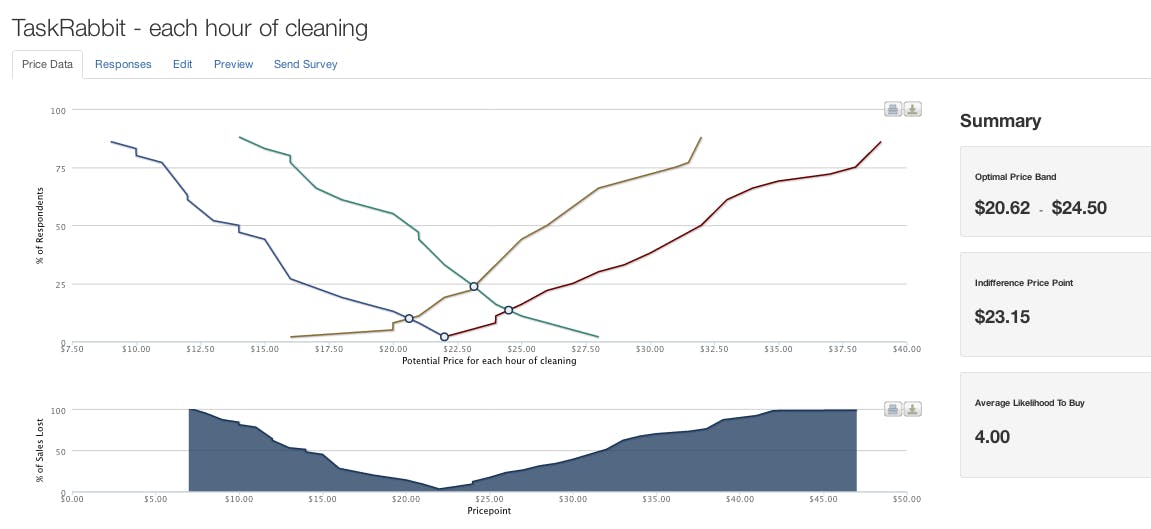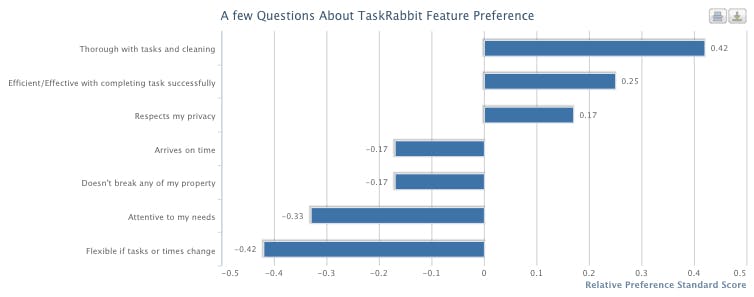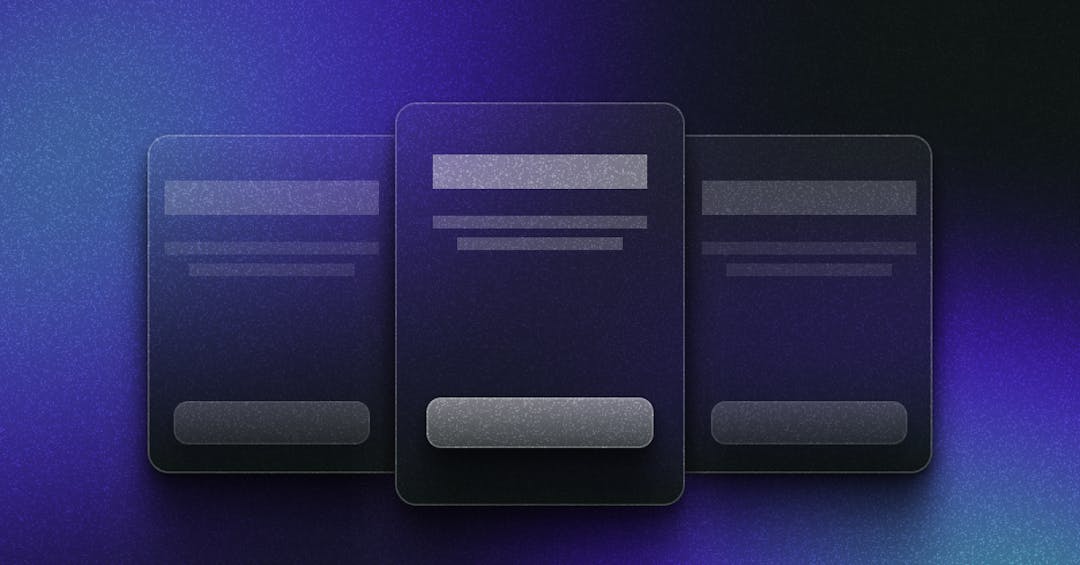TaskRabbit seems like the ideal entrepreneurial setup for those doing the tasks; you set your own schedule. But here's why it is hard to price your services in the beginning.
I’d never really thought about pricing anything until I joined an online labor auctioning website called TaskRabbit. Essentially, it’s a marketplace for people to post all types of odd jobs and errands they'd like to get done. Tasks vary significantly in terms of skill, ranging anywhere from laundry, leaf raking, and walking dogs, to furniture assembly, babysitting, cooking...you get the picture. Some people take it to the extreme, enlisting taskrabbits to write their thank you notes or exchange belongings following a breakup. There really is no such thing as a bad ‘task’ as long as someone is willing to do it.
In a way though, TaskRabbit seems like the ideal entrepreneurial setup for those doing the tasks; you set your own schedule, explicitly state what you’re good at, and pick your own prices. Having never set prices for anything before, I was excited to challenge myself to think in terms of how much I valued my time and skillset. However, you’ll soon find out I had a rough time pricing my services in the beginning.
Pricing in a Blind Auction
At first I approached bidding from a competitor based pricing angle - I researched how much others in the industry were charging for similar services, and priced a bit lower to compensate for my lack of insurance or expertise. Since the tasks ranged significantly across the board, I tried to align my pricing with the amount of effort each errand called for. Time spent cleaning a home could not be priced the same as time spent moving a one bedroom apartment from Cambridge to Brookline, for example. However, I found myself having a difficult time sticking to the prices I set for myself, and in an effort to secure more work, would continually accept bids to do tasks for less money.
Interestingly, as I continued to accept offers to work for less, my valuation of my own time and labor began to get skewed. It also became increasingly difficult to rationalize raising the price back up to a reasonable rate, and I began to get discouraged with what was originally a fun way to do new things, meet people, and make some extra money.
I even experimented with an option that allowed me to simply confirm the fixed price posted by the website, which just made matters worse. By completely taking myself out of the pricing process, I was allowing a stranger to assign value to my skillset and time without having ever experienced it. I started to lose sight of the value of my service, and it left me feeling taken advantage of.
My Pricing Strategy Needed a Tune-Up
I decided to take a step back and see what I could do differently to make more money. First of all, without having a physical product to sell, such as in retail, it didn’t make sense to base my strategy solely on those of my competitors or internal costs of production. In fact, I needed to choose a proper exchange rate for my time, skill, and labor, which meant I had to factor intangible assets into my pricing consideration or risk allowing the market to commodify my unique contribution.
So what is an intangible asset? Intangible assets are assets that have no physical representation, but add significant product value. Generally, this includes intellectual property, brand recognition, copyrights, forecasts, etc., but the skills and abilities an individual brings to a company (or a TaskRabbit auction) are also intangible assets. They’re often the reason one business has a competitive advantage over another. Competitor and cost plus pricing strategies are easier to comprehend and apply because they’re fairly straightforward, but by not attempting to harness the value of the intangible aspects, you’re missing out on an opportunity for profit.
Uncovering the Willingness to Pay of the Taskposters
If I could determine the customers’ willingness to pay for my service, I’d be able to translate the abstract concept of value into a quantifiable price band. Fortunately, the nice folks at Price Intelligently used their value-based pricing tools to query 50 respondents regarding how much they would pay for an hour of housekeeping. At the time, I was only charging $15/hour for housekeeping tasks (most other taskrabbits were charging as much as $30/hour), but perhaps some hard data would prove my fear of losing bids due to higher prices was relatively baseless.
We ran two studies - one to measure price sensitivity, and the other to determine feature value preference. The latter was designed to help assess which aspects of a housekeeping errand customers valued the most, such as efficiency, punctuality, ability to refrain from breaking stuff, etc. All of the participants in the study had a home or apartment that required cleaning, were looking to hire someone to clean, and were familiar with TaskRabbit. The results can be seen below:

The outcome was pretty eye-opening. The price sensitivity campaign revealed the optimal price band for an hour of cleaning was $20.62-24.50, which clearly indicated people were willing to pay a lot more than what I was charging. The indifference price point, or the point at which an equal number of respondents believe a product/service is expensive as believe it is inexpensive, was $23.15. I could easily see how low I was pricing my housekeeping services, as this median price point was 8 bucks more than my hourly fee (check out this post for a deeper look at the mechanics of a pricing study).
The feature value campaign ensured I knew which facets of a housekeeping job, tangible or intangible, were most important to task posters. The features we studied ranked from most important to least important as follows: 1) efficiency, 2) task thoroughness, 3) respecting privacy, 4) arriving on time, 5) not breaking any property, 6) attentiveness to needs, and 7) flexibility. The results of this campaign weren’t quite as surprising, but by looking at the visual output below I was able to confirm that task posters who wanted some cleaning done overwhelmingly preferred a housekeeper that did a quick and meticulous job (although I’m sure nobody wants a TaskRabbit to break their valuables).

Lessons from my first experience pricing, well, anything.
I already had a hunch that I was devaluing my own labor and allowing people to tell me what my time was worth, but the pricing study proved I wasn’t being fair to myself. Ironically, it was my own flexibility with pricing that was devaluing my labor, and setting unreasonably low prices may have even unintentionally communicated a lower quality. As you probably already guessed, I decided to raise my TaskRabbit rates, but here are three lessons anyone can take away from this experience:
1. Communicate your value and don’t be afraid to implement profitable prices.
If you believe in your skills and services, then it’s crucial to become your strongest advocate and learn to communicate your value with a fair price. Although it can be tempting to lower prices to gain market share, you risk unintentionally communicating lower quality by pricing you services well below market value. Neither the buyer nor the seller wins, and the market enters a downward spiral, with buyers paying and receiving less and sellers earning and giving less.
2. Using price as a competitive weapon won’t necessarily get you more business.
Undercutting your competitors on price may program customers to focus only on your price and disregard the value you bring to them. Whether it comes to skilled services or software, the additional value of assets like time, labor, and customer service are true profit drivers, and a more creative pricing strategy is called for. There is no silver bullet or perfect price, but approaching the pricing process with an agile, multi-priced mindset driven by data and value is a great start. This brings me to my last point.
3. Different strokes for different folks
My introduction to the optimal price band showed me different customers will pay different prices for the exact same product or service, and some may be willing to pay more based on their perceived valuations. While that may seem obvious, it’s critical to understand each type of potential buyer if you want to capitalize on different valuations with your pricing strategy. The more you know about your customers’ preferences, interests, and quirks, the easier it will be to align each of them with the right service at a price that works for both of you, whether you offer a software product or you’re cleaning out someone’s garage.
To learn more, check out our Pricing Strategy ebook, or learn more about our price optimization software and solutions. We're here to help!


